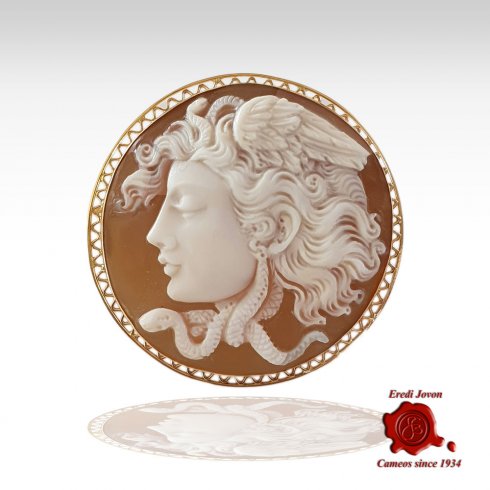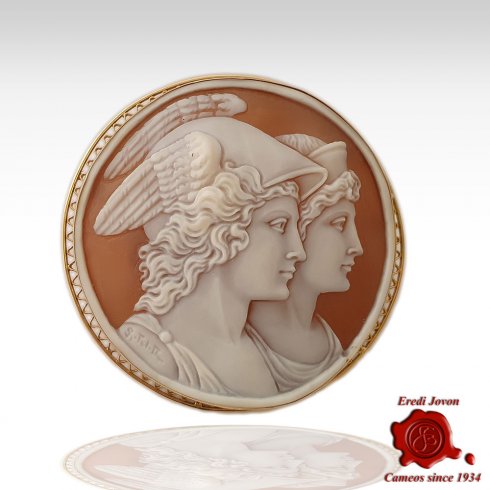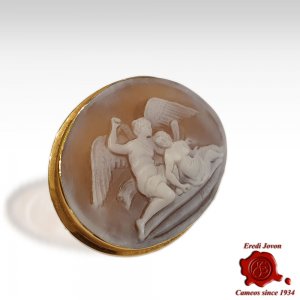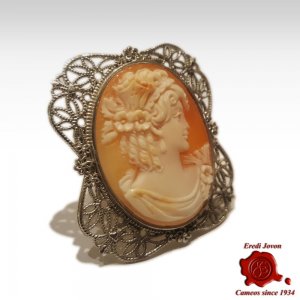The 3 Most Famous Cameos in the World

Is the Cameo History Ancient?
The concept of cameo has a long history that dates back to ancient times. The term "cameo" originally referred to a method of carving gemstones, typically in relief, to create an image or design. The practice of creating cameos can be traced back to ancient civilizations such as the ancient Greeks and Romans.
Here you can have some pills about cameo history
In ancient Greece, cameos were often carved from materials like agate, onyx, and sardonyx. They were used to depict various subjects, including mythological figures, portraits of rulers, and scenes from everyday life. The Romans further developed the art of cameo carving and popularized the use of materials like shell, especially for personalized portraiture.
This is a sample of how is made a cameo in shell.
Throughout history, cameos have been highly valued as decorative items and symbols of status and wealth. They were often worn as jewelry or used to adorn objects such as vases, cups, and furniture. In the Renaissance period, cameo carving experienced a revival, and skilled artisans created intricate and detailed designs.
Which are the 3 most Famous Cameos?
Below are probably the 3 most famous cameos in the world that are renowned for their historical significance, artistic value, or cultural importance. Here are a few notable examples:

Certified Antique Cameos from Italy
The Original Cameo Jewelry From Italy | Handmade and Certified | Worldwide Shipped
Italian Cameo Jewelry1 - Gonzaga Cameo - Russia
Gonzaga Cameo: actually, in the Hermitage Museum of St. Petersburg "is a large ancient Hellenistic gem from the 3rd century AD engraved in a 3 layers sardonyx stone.
It was the masterpiece of the Gonzaga collection of antiquities, first described in a 1542 inventory of Isabella d'Este's collection (The fair lady featured in the cover of the post)
It depicts male and female profiles (which conceivably possess family likeness) and it’s probably intended to suggest Zeus and Hera (many other couples of antiquities were later identified in this cameo for example Alexander the Great and Olympia).
2 - Gemma Augustea - Austria
Gemma Augustea: This Roman cameo from the 1st century AD is considered one of the most significant and intricate cameos in the world. It depicts various mythological scenes and portraits of Roman emperors. It is housed in the Kunsthistorisches Museum in Vienna, Austria.
The Gemma Augustea, also known as the Gem of Augustus, is a magnificent cameo gemstone that dates back to the early 1st century AD during the reign of the Roman emperor Augustus. It is widely regarded as one of the finest examples of ancient Roman cameo craftsmanship.

The Gemma Augustea is carved from a large slice of semi-precious stone, specifically a two-layered sardonyx stone, which combines layers of dark brown sardonyx and white onyx. The cameo measures approximately 19 inches (49 cm) in height and 15 inches (38 cm) in width, making it an impressive and sizable piece..
The Gemma Augustea is an exceptional example of the craftsmanship and artistic skill of ancient Roman lapidaries. It exemplifies the use of cameos as a means of propaganda, reinforcing the status and legitimacy of the emperor and celebrating his achievements. Today, the Gemma Augustea is still considered one of the most important treasures of the ancient world.
3 - Portland Vase - England
Portland Vase: An ancient Roman cameo glass vessel from the 1st century AD, it is renowned for its intricate blue and white cameo design depicting mythological scenes. The vase is currently held at the British Museum in London.
The Portland Vase is a famous and exquisite ancient Roman cameo glass vessel that is widely regarded as one of the finest surviving examples of Roman cameo glasswork. It is named after the Dukes of Portland, who were among its notable owners.
The Portland Vase is believed to have been created in the 1st century AD, during the reign of the Roman Emperor Augustus or Tiberius. It is made of dark blue glass, with a white overlay carved in intricate relief. The vase stands at approximately 25 centimeters (10 inches) tall and is thought to have originally served as a luxurious container for liquids or as a decorative piece. The most remarkable aspect of the Portland Vase is its elaborate and detailed design.
Could you indicate a 4 th one? why not ...

Real Cameos from Italy
Italian Cameo Jewelry Totally Handmade and Certified | Pendant for Necklace, Rings, Earrings and Bracelets
Italian Cameo JewelryAustria Again
4. Habsburg Feldscher Cameo: This cameo, also known as the"Leopoldine-Cameo,"is a large 16th-century cameo depicting the Habsburg family, including Emperor Leopold I of Austria. It is housed in the Kunsthistorisches Museum in Vienna, Austria.
The cameo is a large, oval-shaped stone carving that measures approximately 12.8 cm by 10.9 cm. It is made from two layers of sardonyx, a type of layered chalcedony composed of reddish-brown and white bands. The carving depicts a scene that is believed to represent the Greek god of healing, Asklepios (or Aesculapius), along with other mythological figures.
The Habsburg Feldscher Cameo is notable because it has been linked to the Habsburg family, a prominent European royal dynasty. It was once owned by Emperor Rudolf II (1552-1612) and later became part of the Habsburg art collection. The term"Feldscher"refers to a military surgeon or physician, indicating its association with the medical profession.
Which person is the most depicted in the cameos?
5. Napoleon Cameos: Napoleon Bonaparte, the French military and political leader, was known to be fond of cameos. He commissioned several cameos featuring his likeness and those of his family members, including his wife Josephine and his son Napoleon II.
These are just a few examples of famous cameos, and there are many more notable pieces around the world, each with its own unique historical or artistic value.
I hope you liked this interesting ride across centuries and across this unique and gorgeous art we're trying to keep alive.
The biggest hug in the world

Information
Last post
-

Love Hope Faith Amulet | Meaning and Tradition
Discover the meaning of the Faith, Hope & Charity charm: a timeless amulet to wear every day. A jewel that tells...
-

The Four-Leaf Clover: the rare gift that dares to speak to the heart
Discover the true meaning of the four-leaf clover and its Italian twist with the lucky cornetto charm—a rare story...
-











